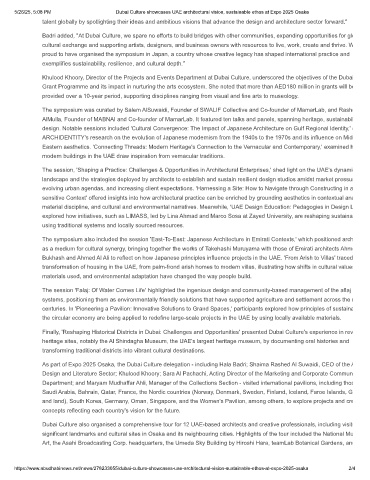Page 344 - MINISTRY OF CULTURE PR REPORT - MAY 2025 (ENGLISH)
P. 344
5/26/25, 5:08 PM Dubai Culture showcases UAE architectural vision, sustainable ethos at Expo 2025 Osaka
talent globally by spotlighting their ideas and ambitious visions that advance the design and architecture sector forward."
Badri added, "At Dubai Culture, we spare no efforts to build bridges with other communities, expanding opportunities for glo
cultural exchange and supporting artists, designers, and business owners with resources to live, work, create and thrive. W
proud to have organised the symposium in Japan, a country whose creative legacy has shaped international practice and
exemplifies sustainability, resilience, and cultural depth."
Khulood Khoory, Director of the Projects and Events Department at Dubai Culture, underscored the objectives of the Dubai
Grant Programme and its impact in nurturing the arts ecosystem. She noted that more than AED180 million in grants will be
provided over a 10-year period, supporting disciplines ranging from visual and fine arts to museology.
The symposium was curated by Salem AlSuwaidi, Founder of SWALIF Collective and Co-founder of MamarLab, and Rashe
AlMulla, Founder of MABNAI and Co-founder of MamarLab. It featured ten talks and panels, spanning heritage, sustainabil
design. Notable sessions included 'Cultural Convergence: The Impact of Japanese Architecture on Gulf Regional Identity,' e
ARCHIDENTITY's research on the evolution of Japanese modernism from the 1940s to the 1970s and its influence on Midd
Eastern aesthetics. 'Connecting Threads: Modern Heritage's Connection to the Vernacular and Contemporary,' examined h
modern buildings in the UAE draw inspiration from vernacular traditions.
The session, 'Shaping a Practice: Challenges & Opportunities in Architectural Enterprises,' shed light on the UAE's dynamic
landscape and the strategies deployed by architects to establish and sustain resilient design studios amidst market pressur
evolving urban agendas, and increasing client expectations. 'Harnessing a Site: How to Navigate through Constructing in a
sensitive Context' offered insights into how architectural practice can be enriched by grounding aesthetics in contextual ana
material discipline, and cultural and environmental narratives. Meanwhile, 'UAE Design Education: Pedagogies in Design L
explored how initiatives, such as LIMASS, led by Lina Ahmad and Marco Sosa at Zayed University, are reshaping sustaina
using traditional systems and locally sourced resources.
The symposium also included the session 'East-To-East: Japanese Architecture in Emirati Contexts,' which positioned arch
as a medium for cultural synergy, bringing together the works of Takehashi Muruyama with those of Emirati architects Ahme
Bukhash and Ahmed Al Ali to reflect on how Japanese principles influence projects in the UAE. 'From Arish to Villas' traced
transformation of housing in the UAE, from palm-frond arish homes to modern villas, illustrating how shifts in cultural values
materials used, and environmental adaptation have changed the way people build.
The session 'Falaj: Of Water Comes Life' highlighted the ingenious design and community-based management of the aflaj
systems, positioning them as environmentally friendly solutions that have supported agriculture and settlement across the r
centuries. In 'Pioneering a Pavilion: Innovative Solutions to Grand Spaces,' participants explored how principles of sustaina
the circular economy are being applied to redefine large-scale projects in the UAE by using locally available materials.
Finally, 'Reshaping Historical Districts in Dubai: Challenges and Opportunities' presented Dubai Culture's experience in rev
heritage sites, notably the Al Shindagha Museum, the UAE's largest heritage museum, by documenting oral histories and
transforming traditional districts into vibrant cultural destinations.
As part of Expo 2025 Osaka, the Dubai Culture delegation - including Hala Badri; Shaima Rashed Al Suwaidi, CEO of the A
Design and Literature Sector; Khulood Khoory; Sara Al Pachachi, Acting Director of the Marketing and Corporate Commun
Department; and Maryam Mudhaffar Ahli, Manager of the Collections Section - visited international pavilions, including thos
Saudi Arabia, Bahrain, Qatar, France, the Nordic countries (Norway, Denmark, Sweden, Finland, Iceland, Faroe Islands, G
and land), South Korea, Germany, Oman, Singapore, and the Women's Pavilion, among others, to explore projects and cre
concepts reflecting each country's vision for the future.
Dubai Culture also organised a comprehensive tour for 12 UAE-based architects and creative professionals, including visits
significant landmarks and cultural sites in Osaka and its neighbouring cities. Highlights of the tour included the National Mu
Art, the Asahi Broadcasting Corp. headquarters, the Umeda Sky Building by Hiroshi Hara, teamLab Botanical Gardens, and
https://www.abudhabinews.net/news/278233055/dubai-culture-showcases-uae-architectural-vision-sustainable-ethos-at-expo-2025-osaka 2/4

